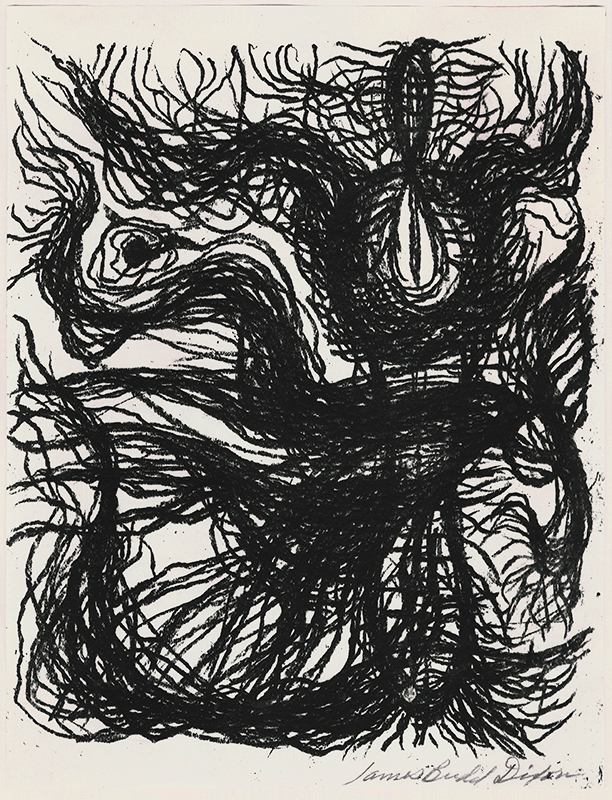
19th, 20th & 21st Century Fine Prints
707-546-7352 · fax 707-546-7924 · web: www.annexgalleries.com · email: artannex@aol.com
Untitled (from Drawings) by James Budd Dixon

Untitled (from Drawings)
James Budd Dixon
Untitled (from Drawings)
James Budd Dixon
1900 - 1967 (biography)This is an impression of a gestural, Abstract Expressionist lithograph by a young James Budd Dixon from what was a collaborative effort by six artists who were students at the San Francisco Art Institute and exhibited together as the "Sausalito Six". The project was conceived as an effort to raise money to assist the Seashore Gallery of Modern Art in Sausalito.
The artists worked with offset printer Eric Ledin in Mill Valley, drawing on flexible aluminum and paper plates with grease crayon, the composition being printed in the same direction as the drawing. The artists then glued the prints at the corners (or upper section) to a heavier support paper which was then signed in pencil. Unfortunately a few of the artists used rubber cement to attach the work and they are usually heavily stained and require conservation.
They created a black construction paper cover with a title sheet glued on which reads: "Drawings / Dixon / Diebenkorn / Hultberg / Kuhlman / Lobdell / Stillman / Published by Eric T. Ledin Mill Valley Calif."
Print scholar David Acton, in his book The Stamp of Impulse: Abstract Expressionist Prints, describes the project thusly: "In about 1948 a group of artists associated with the CSFA [California School of Fine Arts, now the San Francisco Art Institute] began meeting informally in each other's studios, mostly in Sausalito. They were James Budd Dixon, Frank Lobdell, Richard Diebenkorn, George Stillman, and Walter Kuhlman, as well as [John] Hultberg, who recalled that they all wanted to distance themselves from other artists at the school who were overly devoted to Clyfford Still... One day Lobdell gave each of his colleagues paper offset lithography plates. His friend Eric Ledin, who owned a radio and television business, had received an old electric Multilith offset press in lieu of a debt. Ledin set up the machine in the basement of his house in Mill Valley, and as he taught himself to operate it, his friend Lobdell drew on a few aluminum and paper plates. Then he invited his colleagues to participate. Each of the six artists drew two or three plates, which wre printed in Ledin's basement over eight days. They completed seventeen prints in editions of 200 and compiled them in an album, contained in a black paper envelope with a lithographed label. The artists offered the portfolios for sale at some of their exhibitions and in the CSFA bookstore at a cost of one dollar. In the end, the proceeds were just enough to buy a case of scotch and provided a rousing party."
A few portfolios were done in an edition of 17: three each by Diebenkorn, Lobdell and Stillman, two each by Dixon and Kuhlman and Hultberg did four. One of Hultberg's images was allegedly drawn on the plate with butter and the plate broke down after a few impressions were printed. Most portfolios have 16 images and many of the portfolios were broken up, the artists often gifting their prints to friends, and are hard to find complete.
James Budd Dixon was born in San Francisco, California on 26 November 1900. He was raised on his father’s farm in the San Joaquin Valley near Stockton. Dixon studied at the University of California at Berkeley from 1920 to 1923, and at the California School of Fine Arts (CSFA) between 1923 and 1929.
His illustration work of the early 1920s was based upon the Art Nouveau style but in the early 1930s he was painting watercolors of northern California. Dixon worked on the Federal Art Project Works Progress Administration in San Francisco with sculptor Benjamino Bufano. In the 1940s, his work was sporadically included in the annual exhibitions of the San Francisco Art Association. His first solo exhibition was at the San Francisco Museum of Art.
During World War II, Dixon worked as a shipyard draftsman at Bethlehem Steel in San Francisco and later served in an Oakland Army cargo planning unit. After the war, Dixon returned to the SCFA in 1948 as a G.I. Bill student. He associated with the older artists/students [Richard Diebenkorn, Frank Lobdell, Walther Kuhlman, John Hultberg, and George Stillman] and they were later termed The Sausalito Six as most had studios in a repurposed military building near Sausalito’s waterfront. In the summer of 1948, he worked with Stanley William Hayter at SCFA in intaglio printing and later worked in stone lithography.
In 1949, Dixon joined the SCFA’s faculty as a printmaking instructor; he conducted his classes more as an overseer creating an atmosphere that allowed for experimentation. He did influence another generation of artists studying at the SCFA, including Roy de Forest, Sonia Gechtoff, David Simpson, Deborah Remington, and Julius Wasserstein.
James Budd Dixon died in San Francisco, California on December 1, 1967.
